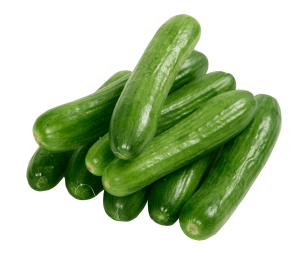CULTIVATION STRATEGY FOR

Cucumber cultivation.
Cucumber is a vegetable belonging to the Cucurbitaceae family, like courgette, pumpkin, melon or watermelon. It is widely consumed worldwide, both fresh and processed, and Spain is the largest producer of cucumbers in the European Union.
This vegetable does not have remarkable nutritional properties, however, it has a high content of potassium and a low content of sodium, which makes it an ideal food for people with hypertension or high uric acid, for example. In addition, if they are eaten with the skin, it is a source of fiber and beta-carotene, which are beneficial for health.
» Cucumber plantation
For cucumber seeds to germinate they need soil temperatures of around 15-16oC. Normally, these vegetables are grown directly in the ground in spring, but if the weather is still cold it is best to sow them in seedbeds.
·Soil
Cucumber cultivation requires light, well-drained soils rich in organic matter, without waterlogging. In addition, the salinity of the soil should not be too high or too low. The optimal pH ranges between 5.5 and 7.
·Climate
Cucumbers prefer warm climates. They adapt to temperatures between 18 to 25oC, with a maximum of 32oC. However, temperatures that are too high cause more male than female flowers to grow, thus harming production.
·Crop rotation
In the cultivation of cucumbers it is important to avoid planting where cucurbits had already been cultivated previously, since they are very voracious plants that can deplete the soil.
» Cucumber care required
·Seedbeds
At the beginning of spring the seedbeds are prepared and after 5-8 days they begin to germinate. After a month, transplants are made to the orchard in sunny areas.
·Soil conditioning for cucumber cultivation
Soil preparation is based on plowing and harrowing to obtain a fine texture and promote root growth.
In addition, organic matter must be applied, such as earthworm humus or compost, since cucumbers are very demanding in nutrients. In addition, this layer of compost helps keep the soil temperature stable.
·Cucumber irrigation
Before sowing, a deep irrigation must be carried out so that the soil has adequate moisture. Subsequently, to ensure proper rooting, the plants are subjected to controlled water stress.
Once the cucumber plants are growing, they need frequent and not very abundant watering , without waterlogging, to avoid fungal diseases such as powdery mildew or mildew. The best irrigation system for cucumbers is drip irrigation.
In the hottest areas, the use of mulch is highly recommended to maintain soil moisture and reduce the amount of irrigation water.
·Trellising
The cucumber plant can be left as a creeper, but due to its great development it is best to support it to keep the plant upright, improve aeration and favor the arrival of sunlight.
Trellising is creating a structure to guide the stems and support the fruits (as is done with tomato plants).
·Stemless
The “Dutch” cucumber variety requires the removal of all lateral shoots, leaving only the main stem.
For the other varieties, the side shoots are not removed, but rather stand out above the second leaf.
·Leafless
During this process, old, yellow or diseased leaves are removed. When the humidity is too high, it is necessary to treat the cuts with fungicidal paste to avoid damage.
·Pollination
Cucumber bushes, as we have already mentioned, have male and female flowers. Therefore, it is required that the latter be pollinated to guarantee the growth of the fruits. For this, there are a series of measures that we can adopt to ensure pollination:
- To attract pollinating insects with other flowers that attract them
- To avoide the use of pesticides.
- To pollinate by hand
- To apply fertilizers rich in potassium, an element that favors the formation of flowers.
» Fertilizers for cucumber cultivation
Cucumber cultivation, as mentioned above, is a demanding crop in terms of nutrients.
The main nutrients it requires are nitrogen,potassium and phosphorus. It is worth highlighting the importance of the nitrogen/potassium ratio throughout the entire crop cycle, while phosphorus plays a determining role during rooting and flowering.
Regarding micronutrients, calcium is a relevant element for the quality of the crop since it favors the defenses of the plants against diseases. In addition, other micronutrients such as iron and magnesium significantly influence the color of the fruit, its quality and the resistance of the plant.
If what we want in an ecological cultivation of cucumbers, we will have to supply these nutritional needs by applying fertilizers and ecological fertilizers, such as compost, earthworm humus, manure or those formulated based on algae, minerals and organic matter.
» Picking cucumbers
Although it depends a lot on the variety, the growing conditions and the final destination of the product (fresh or preserved), generally, the harvest of cucumbers begins 40-70 days after planting.
Harvesting is done when the cucumbers are close to their maximum size, but before they mature. At this time, the tips of the fruit begin to slightly change their color from green to yellow.
Lastly, it is worth mentioning that cucumbers intended for canning must be harvested early, when they measure between 3-9 cm.



